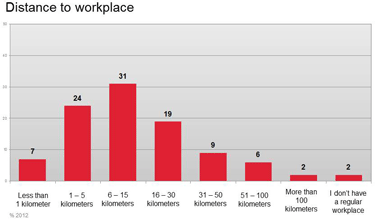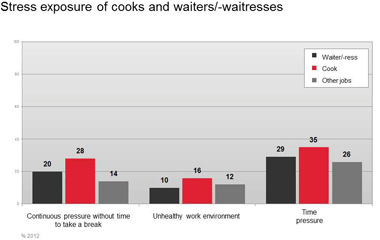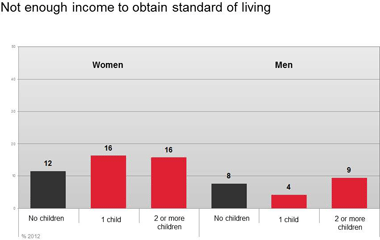Dieses Bild teilen über:
An evaluation of the Austrian Work Climate Index has shown that, for three years now, the share of commuters among the wage earners has remained unchanged at approx. 48 percent.
Considering all employees, it takes less than 15 minutes to get to work for 36 percent of them, 15 to 29 minutes for 35 percent, 30 to 59 minutes for 21 percent, and an hour or longer for seven percent.
Burgenland is the province with the highest share of commuters: 41 percent of the Burgenlanders leave their community of residence to work in another community in Burgenland. 39 percent even commute to another province. In Upper Austria, 55 percent commute within the province, and only two percent outside. Vorarlberg has the highest shares of employees commuting abroad (five percent). Vienna has the lowest share of commuters at all (five percent commuting outside the city limits): nine out of ten work within Vienna. But this may also be due to the narrow definition of a commuter.
The employees having to commute more frequently mainly work in commerce and industry, in education, as well as in the health-care and social sector. Employees in rural areas, too, are more often commuters. However, in these areas the share of commuters has been decreasing in recent years, whereas it has lately increased to 34 percent in cities with more than 20,000 inhabitants (2008: 25 percent).
The car is still the preferred means of transport. 56 percent of all wage earners use the car for the trip to work, among commuters the share is even higher than three quarters (78 percent). Public transport comes second: 15 percent of all employees in Austria use public transport to get to work, and ten percent of all commuters. And there are those who travel part of their way to work by public transport (six percent of all employees, five percent of the commuters).
Considering the often long ways to work and the rising costs related thereto, the Chamber of Labour demands financial relief for the trip to work, as well as better public transport. In spite of some improvements implemented recently, the current system of granting commuting allowance is still inequitable: higher-income earners profit above average, whereas the benefit of low-income earners remains at a lower level. The Upper Austrian Chamber of Labour demands that the allowance should be replaced by a tax allowance amounting to 15 cents each travelled kilometer (single distance).

In Austria, approx. 82,000 employees work as cooks in the catering trade. Many of them are pressed for time and suffer from other stress factors.
All in all, there are almost 190,000 employees working in the accommodation and catering industry. According to the Work Climate Index approx. 2.3 percent of all wage earners belong to the occupational group "cook", which amounts to about 82,000 employees (62 percent of them male, 49 percent less than 35 years old, 30 percent with a migration background). At present, five percent of all cooks are apprentices.
According to the Public Employment Service the average starting salary is 1230 to 1410 euros (gross) each month. All in all, there are approx. 1,700 vacancies in Austria, and some 1,000 apprenticeship vacancies. According to the Public Employment Service many vacancies will remain vacant.
"Many vacancies", this sounds positive, but it also suggests high fluctuation caused, among other things, by problematic working conditions. 45 percent of the cooks polled have been employed in the present company for three years at most, and only 19 percent have been working in the same company for more than 10 years. Considering age as another aspect, the difference to other occupational groups becomes clear: only 33 percent of those older than 36 years have been in the same company for more than 10 years. In other occupational groups this percentage is 47. The higher readiness to change is also reflected by the number of previous employers: only 16 percent of the cooks had only one previous employer, 63 percent had two to five, and 21 percent had six and more. In the other occupational groups only 15 percent had six and more previous employers.

The Public Employment Service describes the working environment of cooks as "work characterized by high time pressure, exposure to heat, seasonal work, very irregular working hours, continuous standing". This is anything but persuasive advertising for the profession, and the Work Climate Index has confirmed that the working conditions are often problematic. 40 percent of the cooks stated that they worked more than 40 hours in an average week, 17 percent said they worked even 45 hours and more. 28 percent of all cooks declared that they had to do overtime "frequently". 29 percent said they often worked nights (between 10 pm and 6 am). 67 percent have to work on Sundays, at least occasionally, 87 percent work on Saturdays - which means that weekend working is part of the job. This is one of the reasons that only 29 percent of the cooks are "very" satisfied with their working hours, another third is "rather satisfied". Therefore, it's no wonder that only 58 percent of the cooks want to stay in their current position. Eleven percent want to change their career, 16 percent the company.
Just as the cooks, waiters/waitresses are exposed to high stress in their jobs.
More than half of the waiters/waitresses are young women.
Almost two thirds of the waiters/waitresses are women (62 pecent). 56 percent are younger than 35 years and 24 percent have a migration background. Clearly more waiters/waitresses than cooks have been in their present company for 3 years at most. This is certainly also due to the age structure which tends to be younger. But: waiter/waitress is not a permanent profession for most of them. Only 18 percent of the waiters/waitresses older than 35 years have been in the same company for more than ten years (other professions: 47 percent). Only twelve percent of the waiters had only one previous employer, 63 percent had two to five, and 25 percent more than five.
33 percent of the waiters/waitresses said that they worked more than 40 hours in an average week (14 percent: more than 45 hours). 26 percent of the waiters/waitresses have to do do overtime "frequently", ten percent work at call. 63 percent "frequently" work on Saturdays, 53 percent frequently on Sundays. The satisfaction with working hours is accordingly low: only 23 percent of the waiters/waitresses are "very satisfied", but another 30 percent are "rather satisfied". Among the other occupational groups satisfaction is clearly higher (36 percent are "very satisfied", 40 percent are "rather satisfied").
On a full-time equivalent basis, cooks earn 1,404 euros net per month on average (median 1,425 euros). This means 150 to 200 euros less than the average of the other employees. Waiters/waitresses earn even less than cooks: the monthly average net income is 1,245 euros (median 1,125 euros). The Work Climate Index of cooks is 103 points. Of late, the average of all employees was 108 points. With waiters/waitresses it is at an alarmingly low value of 99 points. Another consequence of the unfavourable working hours is a poor work-life balance: only 27 percent of the waiters/waitresses (other professions: 36 percent) rate this balance as "very good".
Men with children still work more hours than men without children - the gap has even become wider - whereas women having children tend to work part-time.
The evaluation of the Work Climate Index has confirmed that children are no career setback for men. Things are different for women. 19 percent of the men older than 35 years and having children are in executive positions - compared to 17 percent of the men without children. Among the women over 35 years and having children only nine percent are executives, a little fewer than women without children (ten percent).
Many women consider working part-time as something positive. But the reduction of working hours because of the children also entails some problems. Almost 40 percent of the women with children work 20 to 35 hours a week, 29 percent work even less than 20 hours a week. If women stay in their part-time jobs for too long, a downward spiral is set off: less income, hardly any chances for a career advancement, and low old-age pensions later. What is alarming: 16 percent of the women with one or more children said they could not make ends meet. 35 percent of the mothers said they won't be able to live on their old-age pension.

In some sectors the share of employees having children is higher: health and caring professions, the textiles sector, the food and luxury food industry, energy and water, as well as the paper industry.
The number of employees having children is lower in the real estate business and the data processing sector, in the chemical industry, in culture and sports, as well as in administration and social securities. One might think that in the latter, in particular, job and family should be easily compatible, but only 13 percent of the employees have at least one child, and only ten percent have 2 children.
Therefore, the number of children born to the employees of a sector is just as unfit as an indicator for the sector's child-friendliness and/or a good work-family balance as the part-time employment rate. A good work-family balance can be achieved through working time autonomy, flexibility, and by ensuring an appropriate leadership culture in enterprises.
© 2026 AK Oberösterreich | Volksgartenstrasse 40 4020 Linz, +43 50 6906 0